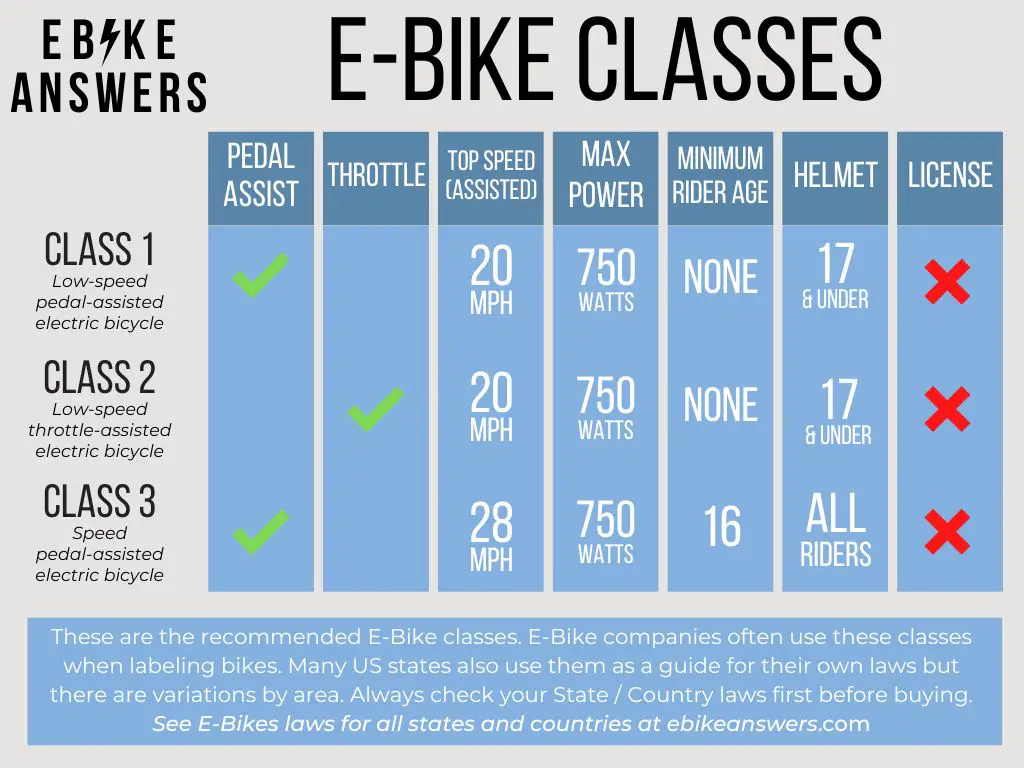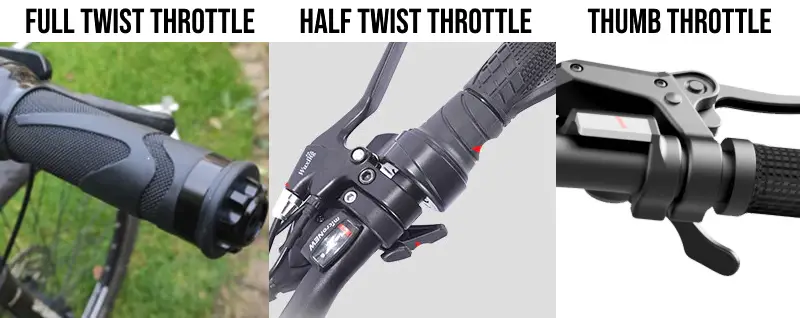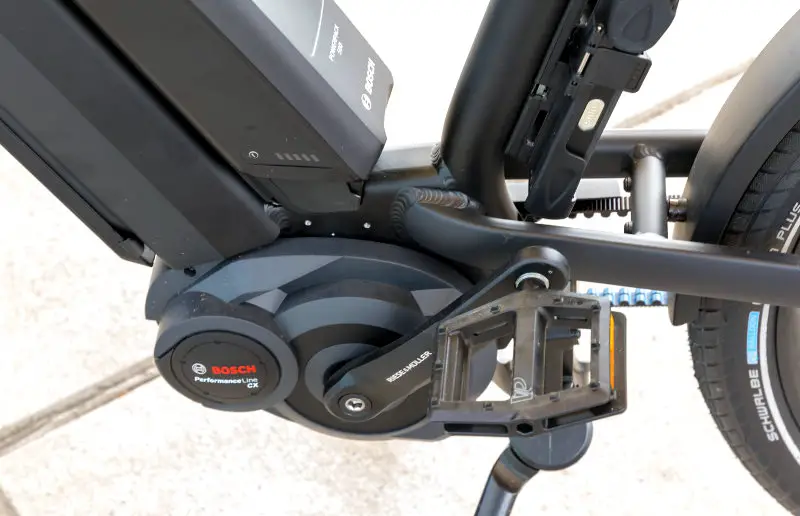If you’re considering getting an e-bike you NEED to know what the electric bike classes are. Read our guide for a simple breakdown of the laws of what Class 1, 2, and 3 e-bikes can and can’t do.
What Are Electric Bike Classes?
In October of 2015 California decided to catch up on the growing electric bike technology and put something into law. Assembly Bill 1096 came into effect in 2016 and defined an electric bike as a “bicycle with fully operable pedals and an electric motor of less than 750 watts (1 horsepower)“.
It created three electric bike classes with different speed limits and rules to make things clearer for buyers. Manufacturers also need to label their bikes with the class number, stop speed, and watt rating.
These are the common classes referred to in the US. It’s common to hear the classes used in other countries but outside the US the laws are often very different so check first.
We’ve broken down the classes and laws a little to help make things clearer. First off you should know the following info:
What Is Pedal Assist / What Is Throttle?
Pedal-assist means that the motor power only kicks in when you pedal. It’s there to give you an extra boost and stops when you stop pedaling. Most bikes have different levels of assistance you can select.
Throttle e-bikes power the motor without pedaling. You can get full twist throttles like a motorbike, half twist which are smaller, or even thumb or finger levers.
You can get both on some e-bikes but most stick to either pedal-assist or throttle because of the rules of the classes.
Read Do You Have To Pedal An Electric Bike?
What Are The Electric Bike Classes?
These are the current three e-bike classes as defined by California law. All three classes must have fully operable pedals and an electric motor of less than 750 watts.
A lot of US states followed and use these classifications but different cities and states also have their own laws. Federal law is again different and hasn’t quite caught up.

What Is A Class 1 Electric Bike?
Class 1 E-Bikes are pedal assist and are allowed to assist you up to 20 miles per hour. This means that only while pedaling the motor can help you get up to 20mph and should stop assisting you after – though you can pedal/coast faster.
There is no minimum age to ride a Class 1 electric bike, and you do not need a driver’s license or license plate. Riders 17 and under must wear a helmet while riding.
These are the original Californian regulations and may be different in your state. These are known as a low-speed pedal-assisted electric bicycle.
What Is A Class 2 Electric Bike?
Class 2 Electric bikes use a throttle to accelerate and can assist up to 20 miles per hour. This means the motor can help you get up to 20mph and should stop assisting you after – though you can pedal/coast faster.
There is no minimum age to ride a Class 2 electric bike, and you do not need a driver’s license or license plate. Riders 17 and under must wear a helmet while riding.
These are the original Californian regulations and may be different in your state. Class 2 is also known as a low-speed throttle-assisted electric bicycle.
What Is A Class 3 Electric Bike?
Class 3 E-Bikes are pedal assist and are allowed to assist you up to 28 miles per hour. Class 3 E-Bikes must also have a speedometer. Again, the motor can help you get up to 28mph only while pedaling and should stop assisting you after but you can pedal/coast faster.
The minimum age to ride a Class 3 electric bike is 16. You don’t need a driver’s license or license plate. Riders of all ages must wear a helmet.
These are the original Californian regulations and may be different in your state. Class 3 is also known as a speed pedal-assisted electric bicycle.
Is There A Class 4 For Electric Bikes?
There is no legal Class 4 for E-Bikes in the US or outside. However, many people refer to anything that goes above 28mph, or that can be powered by both pedal assist and throttle, or is over 750 as a Class 4 E-bikes.
Technically, electric-powered bikes that go over 28mph – whether they are pedal-assist or throttle – would be classified as a moped or motorbike and subject to the same laws. That means you’d need a license and – depending on the state – a helmet and license plate, with a minimum age.
There is a type of bikeway called a Class 4 in California. A bikeway is a bike path like a trail or a route next to a road, with classes from 1 to 4. These don’t correspond to e-bike classes.
Can Electric Bikes Have Pedal Assist And Throttle?
Yes, many e-bikes have pedal assist and throttle. Though according to the original California law as written, this shouldn’t really be the case. The federal law is clear that Class 1 and 3 are pedal-assist only and Class 2 is throttle.
States’ laws do differ so there are lots of disagreements. Some states change the Class definitions to allow both, or having throttle only work if you pedal, or the throttle only goes to 20mph but you can pedal up to 28mph with power…

Many companies sell e-bikes with both features and leave it up to you. Some companies make the same bike but disable the features (or allow you to manually select them) based on where they are being sold or where you ride.
Rad Power and others sell Class 2 bikes with both, as they would argue the law says both are OK. Some Class 1 bikes have throttles that only work if you are already pedaling, acting as a boost. Again, lots of gray areas here.
What Class Of E-Bike Can Go On Sidewalks / Roads / Trails?
Every country, state, and sometimes cities have their own regulations on what classes of e-bike can go where. Check out our guides to e-bike laws in every state to find out which classes can go where you live.
Why Are The E-Bike Classes Like This?
There are very good arguments for allowing e-bikes to have both pedal assist and throttle. For example, using a throttle where pedaling isn’t as safe because of stability. Accelerating at a green light in traffic or going over a very bumpy road surface.
It’s also very important to not assume that everyone uses bikes for working out. There are huge arguments for having a clean energy, easy to access transport method. People with different abilities also deserve the same access to biking as others.
You might well ask what are the electric bike classes good for if they aren’t fit for purpose.
What Is The Best Class Of E-Bike?
Honestly, we think the best solution is to get an e-bike than can do them all but the mode or class can be chosen. A lot of e-bikes allow you to select a mode that conforms to a Class by using a toggle on the controller, a physical switch, or an app.
If that’s not an option, stick to what you’ll definitely use and what is legal where you are. If you’re happy to pedal everywhere and do some work then a Class 1 will save battery and give plenty of help. Think about Class 3 if you need the power and it’s legal where you’ll ride it.
If you’re just here for transport or to enjoy a nice scenic day out without non-stop pedaling then go for Class 2. Double-check they’re legal where you are and check that you don’t need to pedal for the throttle to work.
Want our expert recommendation? Check out the Best Electric Bike For The Money
Do E-Bikes Need To Have Pedals?
By US law – yes, all three classes of electric bikes must have operable pedals. That doesn’t mean the pedals are the only way you can use the motor. Class 2 E-Bikes are throttle operated so in theory you could never move the pedals at all and just use the throttle to move you around.

Can You Modify Electric Bikes?
Yes, many can get software or controller modifications that unlock power or speed limits. Is it legal? If you go out of the Class structure or over 750W – technically no if you use your bike in public.
There are some cases that could be argued as legal and justified. It’s also fine to modify your bike to be more powerful or add more modes as long as you stay within the legal limits.
As an example, some states allow only Class 1 e-bikes on trails and bike lanes, with Class 2 and 3 reserved for roads. Often electric bike models let you choose the mode on the display or with a removable key to unlock the speed and power, making you agree to use the bike according to your state laws.
To us this makes sense and it should be the behaviors that are regulated and not necessarily the technology or power. This is as long as it makes sense and can be done safely.

Are DIY E-Bikes Legal?
As long as they conform to local laws about bicycle safety and e-bike classes – Yes. Upgrading a normal bicycle to an e-bike is easy with kits and instructional videos.
You could even weld together your own frame and shocks, construct a motor, build a battery from cells, then buy a customizable controller. Read all about electric bike batteries.
Is 750 Watts The Max For An E-Bike?
By Californian laws and many others, yes 750 Watts is the max power an e-bike motor can be. Are the motors that come with e-bikes only capable of 750 Watts output? Not really.
The thing is 750W isn’t that much power if you are off-road, going uphill a lot, or want good acceleration from a stop. Most modern e-bike motors can actually output way more than 750W but don’t advertise it.
Why? Well, they tend to measure the power by the continuous power the bike could put out without overheating, instead of the peak power it could provide. You’ll often see them marked as 750W Rated for legal purposes.
It’s a case of underselling capacity to provide a competitive product. Read more about peak and continuous current in e-bike batteries. In Canada for example the max output is 500W but you’ll find mostly the same motors used as in the US.
What Is US Federal Law For Electric Bikes?
The federal law (Public Law 107-319) on electric bikes defines a low-speed electric bicycle as a two- or three-wheeled vehicle with fully operable pedals and an electric motor of less than 750 watts with a maximum speed of 20 miles per hour.
However, this law was mainly to regulate e-bikes as consumer products. That means when you buy one you’ll be protected by consumer law and safety laws as if you were buying a normal bicycle.
It also specifically says these types of e-bikes aren’t motor vehicles. However, not that the law only covers up to 20 miles per hour. So technically if you buy a bike over that limit you might not be protected by consumer law.
Though federal law normally trumps state laws, this law was just about consumer rights. So local states and cities can still define e-bikes as whatever they’d like and still have control over their own laws on traffic, speed, where you can and can’t ride, helmets, licensing, and age regulations.
Modified e-bike image courtesy of Ian Hughes @ flickr
